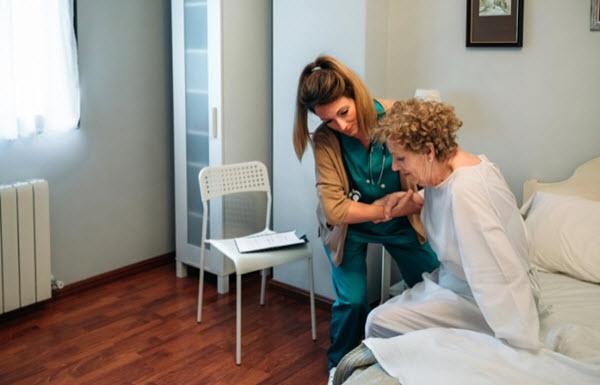Why Nurses Should Do Strength Training

One of my greatest fears as a nurse used to be something you’d probably never guess. I have plenty of anxieties working as a nurse: making an error that could harm a patient, not being able to find parking and clocking in late, or not having enough caffeine before starting my shift, resulting in me being able to communicate only in grunts and growls. But these aren’t the things that caused me my greatest fear. No, my greatest fear as a nurse used to be a permanent injury to my back while doing something simple and mundane like bending over to pick up the pen I just dropped.
You know what I’m talking about. Lots of us have seen some variation of this meme and chuckled at it:
Me as a kid:
Falls six feet off the jungle gym and immediately jumps up, declaring “I’m fine!”
Me as an adult:
Sneezes once and now has to wear a neck brace for two weeks.
We laugh at it because we know there’s truth in it. The smallest of movements, like sneezing, or bending down to tie our shoe, seem to result in outcomes like muscle strains, joint sprains, or full body traction. Nurses make lots of different movements throughout their shifts: squatting, bending, reaching, lifting, cartwheeling, tap dancing. Many hospitals post their job openings with detailed descriptions of those jobs, which include the percentage of a nurse’s shift that’s spent making these movements. I’m not kidding! I’ve read job descriptions that include long lists of requirements of the job, which, strangely enough, do not include skills like “keep patients alive” or “don’t get Dr. Rosenfeld mad.” These job descriptions list their requirements as “bending—50% of the time,” “stooping—75% of the time,” or “standing—200% of the time.”
With all of this bending, stooping, and standing for 16 out of 12 hours, it’s no wonder that many nurses talk about ongoing pain. But it doesn’t have to be that way!
Most Nurses Have Pain

Ask almost any nurse and they will tell you about some sort of constant, nagging pain related to working long shifts on their feet that require them to rack up well over 10,000 steps a day:
- aching feet
- stiff knees
- tired legs
- tight hips
- and everyone’s favorite: back pain
I had back pain bothersome enough that I legitimately began to fear one day not being able to do my job and having to find another, less physically demanding career like playing professional football. Until I decided to be proactive and change my health by starting strength training.
Strength Training is NOT Body Building
The term “strength training” might bring up images of The Rock pumping some serious iron, or of a group of guys in string tank tops, nipples on full display, clustered around another guy trying to bench press 700 pounds while yelling out encouraging phrases like “dig, bro, dig!” or “Yeah!” This is not what I mean when I say “strength training.”
Strength training is what it says it is: training your strength abilities. It is consistent repetition of moving your muscles and connective tissues in patterns that require them to strengthen in order to accommodate the load you’re putting on them. For some people, this does mean bench pressing a Fiat, or picking up those gigantic tires which I’m sure were left on the ground for good reason. Their goals are to get crazy strong and build some seriously jacked muscles. My goal is to move through the motions of my daily life without pain. I think most nurses have a similar goal, whether they realize it or not.
Think about some of the most commonly performed nursing responsibilities:

- Help lift an elderly patient up out of the chair so she can go to the bathroom.
- Hold the patient’s waist while she slowly lowers down onto the toilet.
- Stand in one place just outside the bathroom door for anywhere from 6 minutes to the rest of your shift while peeking inside periodically to be sure the patient hasn’t fallen asleep on the toilet.
- Help lift her off the toilet while she tightly grips your arms with hands she hasn’t washed yet.
In that one instance of patient care, the nurse experienced lifting, holding, squatting, and potential exposure to infectious disease. Her leg muscles, back muscles, hips, and shoulders were all utilized and put under a certain amount of stress. And then she went to the next patient’s room and did it all over again.
Doing regular strength training can help the muscles we use to get us through our shifts become more adaptable and more capable to the movements we make repeatedly throughout the day. Stronger, more pliable muscles and connective tissues enables us to move more fluidly, to have better physical endurance of our long shifts, and to have arm wrestling matches at the nurses station to see whose biceps are the unit champion.
How To Learn How To Strength Train
In the age of the internet, social media, and apps, there are plenty of options to learn a particular type of exercise like strength training.
- Instagram: The social media platform is full of educated, trained, and credentialed fitness experts. It is also full of very attractive, physically fit people who have no legitimate training in the field but who claim they can effectively train you into better physical health. So far, the only thing any of them have succeeded in training ME in is scrolling mindlessly just to look at the pretty people. Take care to vet whoever you choose to follow or reach out to for guidance.
- YouTube: Similar to Instagram in the way it can be used.
- Personal trainers: For those who prefer face to face coaching and instruction and who don’t mind being given potentially awkward instructions like “lower that butt down” during a squat or “push those knees apart” during hip abductions.
- Fitness apps: There are free ones and there are paid ones, depending on how much you’re willing to pay for what they offer. GymFit, Strong Workout Tracker, and Nike Training Club are a few of many worth checking out.
Your Health, and Your Career, are Worth It
Nurses serve a vital role in society. We take care of those who cannot take care of themselves. In order to do that to the best of our ability, we have to first take care of ourselves. In addition to eating healthy foods and not just crackers from the nutrition room, resting and sleeping sufficiently (night-shifters, I know accomplishing this is probably harder than passing nursing school), enjoying leisure time and time with the ones we love (including ourselves!), and safeguarding our mental health, this also means strengthening and conditioning our physical bodies for the physically demanding work we do. We need to train our muscles and tissues to carry us through our jobs just like we trained our brains to make us excellent nurses.
Author Bio
Elizabeth Ring is a Registered Nurse with eighteen years of experience taking care of adult and pediatric patients. Her career has taken her from her beginnings in Med-Surg to the Imaging Department, Interventional Radiology, Emergency Department, and landed her in the specialty of Vascular Access, which is her nursing niche. She feels passionately about empowering patients through education and information, and assisting her fellow nurses in continuous professional growth. She uses writing as a means of accomplishing these goals.
is a Registered Nurse with eighteen years of experience taking care of adult and pediatric patients. Her career has taken her from her beginnings in Med-Surg to the Imaging Department, Interventional Radiology, Emergency Department, and landed her in the specialty of Vascular Access, which is her nursing niche. She feels passionately about empowering patients through education and information, and assisting her fellow nurses in continuous professional growth. She uses writing as a means of accomplishing these goals.







